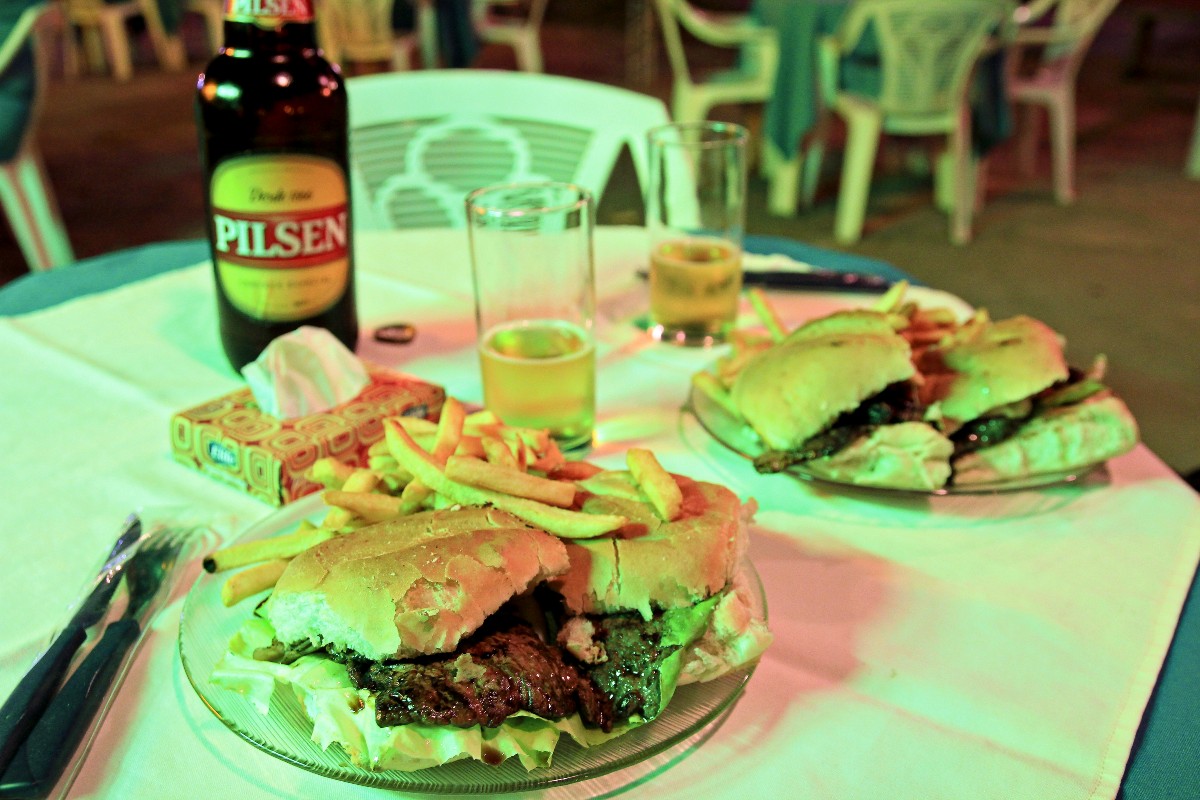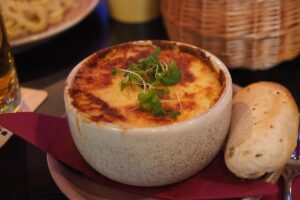Welcome, fellow food enthusiasts, to a culinary journey through the heart of Uruguay! Get ready to tantalize your taste buds and explore the diverse and delectable world of traditional Uruguayan cuisine. Uruguay, a country nestled between Argentina and Brazil, boasts a rich culinary heritage that reflects its unique blend of European and indigenous influences. In this comprehensive guide, we will dive into the most popular and authentic dishes that define Uruguayan food culture. From the iconic Asado to the comforting Ñoquis, prepare to embark on a gastronomic adventure and discover the true essence of Uruguayan flavors.
1. Asado: A Celebration of Uruguayan Barbecue
Recipe:
Key Ingredients:
- Various cuts of beef, chorizo, morcilla, chicken, and pork
- Salt
- Chimichurri sauce (optional)
Where to try it:
For an unforgettable Asado experience, head to La Pulpería in Montevideo. This renowned restaurant is a favorite among locals and tourists alike, offering a wide selection of grilled meats cooked to perfection in a traditional setting.
2. Chivito: Uruguay’s Iconic Steak Sandwich
But that’s just the beginning! The Chivito comes in countless variations, with some restaurants adding bacon, fried or hard-boiled eggs, olives, and even heart of palm. It’s a true culinary adventure, and each bite is a celebration of Uruguay’s rich flavors and gastronomic creativity.
Recipe:
https://thehungarybuddha.com/2019/09/20/chivito-uruguayan-steak-sandwich/
Key Ingredients:
- Thinly sliced steak (churrasco)
- Ham
- Mozzarella cheese
- Tomatoes
- Lettuce
- Mayonnaise
- Crusty bread roll
- Bacon, fried or hard-boiled eggs, olives, heart of palm (optional)
Where to try it:
For an authentic and mouthwatering Chivito experience, make your way to El Tinklado in Montevideo. This popular restaurant is known for its generous portions, fresh ingredients, and dedication to traditional Uruguayan cuisine.
3. Milanesa a la Napolitana: A Taste of Italy in Uruguay
This hearty and satisfying dish is often served with a side of french fries or mashed potatoes, making it a popular choice for both lunch and dinner.
Recipe:
https://www.tasteatlas.com/milanesa-napolitana/recipe
Key Ingredients:
- Beef or chicken cutlet
- Breadcrumbs
- Eggs
- Flour
- Tomato sauce
- Ham
- Mozzarella cheese
- Olive oil
- Salt
- Pepper
Where to try it:
For a truly authentic Milanesa a la Napolitana experience, visit La Pasiva in Montevideo. This renowned restaurant is a local institution, known for its classic Uruguayan and Italian dishes.
4. Capeletis a la Caruso: A Taste of Italian Heritage
The dish is believed to have been created by an Italian chef named Caruso who immigrated to Uruguay in the early 20th century. Capelletti a la Caruso quickly became a beloved classic in Uruguayan cuisine, and it is often enjoyed on special occasions and family gatherings.
Recipe:
https://southamericawineguide.com/ultimate-recipe-for-uruguayan-capeletis-a-la-caruso/
Key Ingredients:
- Capelletti pasta
- Veal
- Spinach
- Ricotta cheese
- Cream
- Butter
- Parmesan cheese
- Nutmeg
- Ham or mushrooms (optional)
Where to try it:
For an authentic and unforgettable Capelletti a la Caruso experience, visit Ristorante Da Carmine in Montevideo. This renowned Italian restaurant is known for its traditional dishes and warm, inviting atmosphere.
5. Ñoquis: A Comforting Dumpling Dish
Recipe:
https://www.ilolay.com.ar/es/recetas/noquis-de-calabaza-con-bolognesa
Key Ingredients:
- Potatoes
- Flour
- Eggs
- Ricotta cheese (optional)
- Sauce (tomato sauce, pesto, or butter and sage)
- Salt
- Pepper
Where to try it:
For a truly authentic Ñoquis experience, visit Bar Facal in Montevideo. This historic bar and restaurant is a local institution, known for its traditional Uruguayan and Italian dishes.
6. Pescado a la Plancha: A Celebration of Fresh Seafood
Recipe:
https://www.cocinadelirante.com/receta/carne/como-marinar-pescado-la-plancha
Key Ingredients:
- Fresh fish (sea bass, corvina, brótola, or other local varieties)
- Olive oil
- Salt
- Pepper
- Lemon juice
- Roasted vegetables or salad
Where to try it:
For a delightful Pescado a la Plancha experience, head to La Huella in José Ignacio. This beachside restaurant is known for its fresh seafood, relaxed atmosphere, and stunning ocean views.
7. Buñuelos de Acelga: Savory Swiss Chard Fritters
Recipe:
https://www.paulinacocina.net/bunuelos-de-acelga/27279
Key Ingredients:
- Swiss chard
- Flour
- Eggs
- Onions
- Garlic
- Spices (such as cumin, paprika, and black pepper)
- Salt
- Oil for frying
- Dipping sauce (chimichurri or aioli)
Where to try it:
For a taste of authentic Buñuelos de Acelga, visit Jacarandá in Montevideo. This traditional restaurant is known for its classic Uruguayan dishes and warm, inviting atmosphere.
8. Churrasco: A Celebration of Grilled Meats
Recipe:
https://www.seriouseats.com/churrasco-steak-recipe-7968650
Key Ingredients:
- Various cuts of beef, pork, lamb, and chicken
- Salt
- Pepper
- Chimichurri sauce
Where to try it:
For an unforgettable Churrasco experience, head to La Cava in Punta del Este. This renowned steakhouse is a favorite among locals and tourists alike, offering a wide selection of premium cuts of meat cooked to perfection in a stylish setting.
9. Cordero al Horno de Barro: A Flavorful Clay Oven Roasted Lamb
Recipe:
Key Ingredients:
- Lamb
- Herbs (such as rosemary, thyme, and oregano)
- Spices (such as garlic powder, paprika, and cumin)
- Red wine
- Salt
- Pepper
- Olive oil
- Roasted vegetables or salad
Where to try it:
To experience the authentic flavors of Cordero al Horno de Barro, visit Parrillada La Estancia in Montevideo. This traditional Uruguayan restaurant is known for its expertly cooked meats and warm, welcoming atmosphere.
10. Revuelto Gramajo: A Hearty Breakfast or Late-Night Snack
Recipe:
https://www.happy-mothering.com/revuelto-gramajo/
Key Ingredients:
- Eggs
- Diced ham
- Thinly sliced potatoes
- Onions
- Peas
- Salt
- Pepper
- Oil or butter for cooking
- Cheese, bacon, or other vegetables (optional)
Where to try it:
For a truly authentic Revuelto Gramajo experience, visit Bar Tabaré in Montevideo. This historic bar is a local favorite, known for its traditional Uruguayan dishes and lively atmosphere.
Conclusion: A Culinary Adventure Awaits in Uruguay
Uruguay’s traditional food is a delightful fusion of flavors, reflecting the country’s rich culinary heritage and diverse cultural influences. From the iconic Asado and Chivito to the comforting Ñoquis and Revuelto Gramajo, each dish offers a unique and unforgettable culinary experience.
So pack your bags, grab your appetite, and embark on a culinary adventure through Uruguay. With this comprehensive guide in hand, you’ll be well-equipped to navigate the country’s vibrant food scene and discover the authentic flavors that make Uruguayan cuisine so special. And remember, the best way to experience Uruguay’s traditional food is to savor it with friends and family, just as the locals do.




